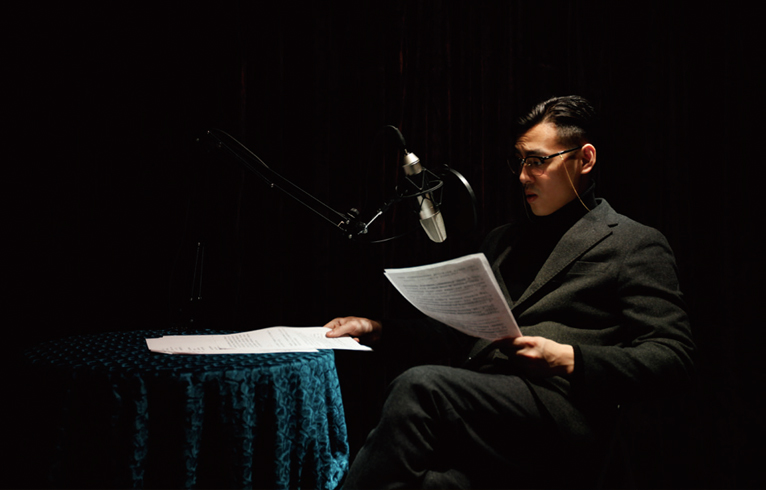LI RAN: MONT SAINTE-VICTOIRE
| June 5, 2012 | Post In LEAP 14

In the past couple of years, performance art has seen a resurgence in popularity on the international art scene, at the same time igniting in China renewed enthusiasm for theoretical writings, especially translated texts. Li Ran’s recent solo exhibition stands at the crossroads of these two trends. The exhibition’s title is directly borrowed from Cézanne’s famous series of paintings, “Le Mont Saint-Victoire.” Its content, however, is a combination of performance and video installation.
The exhibition’s key performance happened on opening night. Inside the gallery, a wall separated the performance space from viewers. Through a hole in the wall, audience members could peer into a narrow space barely large enough for the props: one small round table covered with a green velvet tablecloth, one chair, and hanging behind it all, dark red velvet curtains. The viewer’s line of vision, however, fell on an exaggeratedly large condenser microphone.The artist sat cross-legged at the table, his shiny hair combed back and his gold eyeglass chain out of place next to his gray suit, as if purposefully exposing an impostor’s defects. During the performance, the artist read from the script in his hand like a voiceover actor, using different voices for difference parts and altering his gestures and inflections according to changes in the texts.
Prior to this exhibition, Li Ran most often appeared in public as a member of the “Company” collective. In “Mont Sainte-Victoire,” which is also Li’s first solo exhibition, topics previously explored by “Company” are also present, such as the methods of an artist’s practice, art history and institutional pressure, anti-modernist attitudes, and more. All of these are expressed via the script that Li himself wrote, and which he reads during the performance.
The performance, later exhibited on video, takes place over four acts. Interspersed within the script are carefully chosen excerpts from translated theoretical works, which when pieced together create a new dramatic context for the performance. For example, selections from Roland Barthes’ The Pleasure of the Text are included in act two; and a passage about psychiatry from Michel Foucault’s Madness and Civilization appears in act three. When thoughts turn to accuracy of the translations, however, one is reminded of subpar efforts that err on the side of style over content, and the performance’s inclusion of these borrowed words thus carry a whiff of ridicule. This, while choosing to perform as a voiceover actor is already stiffly ironic; audiences prefer to watch films with the original actors’ voices, not second-hand imitations.
But mockery and ridicule are not the goals of Li Ran’s exhibition, even though the artist’s roaming reference points and insistence on faking out the viewer can lead to confusion. During the last two acts, titled “Tournament” and “Chance Encounter,” the focus shifts from questions about art to literary representations of the dimensions of humanity. This transition is foreshadowed in the first two acts, “Reflected View” and “Gaze.” The overall effect that emerges from a seemingly empty background are flashes of human yearning for spiritual connections.
At the performance’s end, a video recording of what just took place is projected onto the opposite gallery wall. The size of the video image is the same as the opening through which the audience watched everything unfold. In this moment, the performer and his performance have doubled their presence in the gallery; the performer is present at the same time as the performance, which is represented through the medium of video. Suddenly the live performance does not seem so necessary. Posed against the other three projections— showing slides of images from the history of art— this video of the performance seems more appropriately in dialogue with the setup than the performance itself. Dai Weiping (Translated by JiaJing Liu)

